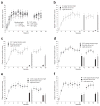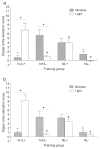Nicotine competes with a visual stimulus for control of conditioned responding
- PMID: 20579006
- PMCID: PMC5483176
- DOI: 10.1111/j.1369-1600.2010.00228.x
Nicotine competes with a visual stimulus for control of conditioned responding
Abstract
Environmental stimuli that co-occur with tobacco use come to evoke drug-related conditioned responses (CRs) that appear involved in continued use of nicotine-containing products. In rats, nicotine can serve as a conditional stimulus (CS) for non-drug unconditioned stimuli (USs), prompting the question of whether the nicotine CS can compete with, or overshadow, a non-drug environmental stimulus for control of a CR. In Experiment 1, male Sprague-Dawley rats were assigned to a group [0, 0.01, 0.03, 0.045, or 0.06 mg nicotine (base)/kg/infusion]. During each session, there were 10 intravenous infusions followed by a 30-second houselight to form a compound CS. At light offset there was 4-second access to sucrose. For Experiment 2, groups were nicotine (0.03 mg/kg/infusion) + light compound paired, nicotine + light compound unpaired, nicotine paired and light unpaired, and nicotine unpaired and light paired. Paired stimuli were presented with sucrose similar to Experiment 1. Unpaired stimuli were temporally separated from sucrose. Following acquisition, tests of nicotine and light alone were conducted by intermixing non-reinforced trails into training sessions. Nicotine dose-dependently overshadowed the light CS as shown by reduced light control of conditioned responding with higher doses. The nicotine, light, and nicotine + light compound had to be paired with sucrose to evoke a CR. These results demonstrate nicotine overshadows an exteroceptive visual stimulus. Because exteroceptive stimuli are often the focus of cue-exposure therapy, such competition may help begin to explain the marginal effectiveness of these therapies.
© 2010 The Authors. Addiction Biology © 2010 Society for the Study of Addiction.
Figures




Similar articles
-
Excitatory conditioning to the interoceptive nicotine stimulus blocks subsequent conditioning to an exteroceptive light stimulus.Behav Brain Res. 2011 Aug 1;221(1):314-9. doi: 10.1016/j.bbr.2011.03.020. Epub 2011 Mar 17. Behav Brain Res. 2011. PMID: 21419807 Free PMC article.
-
Conditioned reinforcement in rats established with self-administered nicotine and enhanced by noncontingent nicotine.Psychopharmacology (Berl). 2007 Dec;195(2):235-43. doi: 10.1007/s00213-007-0897-6. Epub 2007 Aug 5. Psychopharmacology (Berl). 2007. PMID: 17676401 Free PMC article.
-
Operant responding for conditioned and unconditioned reinforcers in rats is differentially enhanced by the primary reinforcing and reinforcement-enhancing effects of nicotine.Psychopharmacology (Berl). 2006 Nov;189(1):27-36. doi: 10.1007/s00213-006-0522-0. Epub 2006 Sep 22. Psychopharmacology (Berl). 2006. PMID: 17019569
-
Characterization of nicotine's ability to serve as a negative feature in a Pavlovian appetitive conditioning task in rats.Psychopharmacology (Berl). 2006 Mar;184(3-4):470-81. doi: 10.1007/s00213-005-0079-3. Epub 2005 Jul 27. Psychopharmacology (Berl). 2006. PMID: 16047193
-
Acquired appetitive responding to intravenous nicotine reflects a Pavlovian conditioned association.Behav Neurosci. 2009 Feb;123(1):97-108. doi: 10.1037/a0013735. Behav Neurosci. 2009. PMID: 19170434 Free PMC article.
Cited by
-
Use of the overexpectation effect to reduce conditioned seeking behavior controlled by nicotine.Psychon Bull Rev. 2024 Dec;31(6):2758-2766. doi: 10.3758/s13423-024-02524-1. Epub 2024 May 20. Psychon Bull Rev. 2024. PMID: 38769272
-
Pavlovian conditioning with the internal stimulus effects of intravenous nicotine heightens later nicotine taking with variation by dose and sex.Sci Rep. 2025 Feb 14;15(1):5500. doi: 10.1038/s41598-024-84145-1. Sci Rep. 2025. PMID: 39952959 Free PMC article.
-
Stimulus functions of nicotine.Adv Pharmacol. 2022;93:133-170. doi: 10.1016/bs.apha.2021.11.001. Epub 2022 Jan 12. Adv Pharmacol. 2022. PMID: 35341565 Free PMC article.
-
Appetitive Pavlovian conditioning of the stimulus effects of nicotine enhances later nicotine self-administration.J Exp Anal Behav. 2022 May;117(3):543-559. doi: 10.1002/jeab.740. Epub 2022 Feb 22. J Exp Anal Behav. 2022. PMID: 35192221 Free PMC article.
-
Excitatory conditioning to the interoceptive nicotine stimulus blocks subsequent conditioning to an exteroceptive light stimulus.Behav Brain Res. 2011 Aug 1;221(1):314-9. doi: 10.1016/j.bbr.2011.03.020. Epub 2011 Mar 17. Behav Brain Res. 2011. PMID: 21419807 Free PMC article.
References
-
- Alessi SM, Roll JM, Reilly MP, Johanson C-E. Establishment of a diazepam preference in human volunteers following differential-conditioning history of placebo versus diazepam choice. Exp Clin Psychopharmacol. 2002;10:77–83. - PubMed
-
- Becker KM, Rose JE, Albino AP. A randomized trial of nicotine replacement therapy in combination with reduced-nicotine replacement therapy in combination with reduced-nicotine cigarettes for smoking cessation. Nicotine Tob Res. 2008;10:1139–1148. - PubMed
-
- Besheer J, Palmatier MI, Metschke DM, Bevins RA. Nicotine as a signal for the presence or absence of sucrose reward: a Pavlovian drug appetitive conditioning preparation in rats. Psychopharmacology. 2004;172:108–117. - PubMed
-
- Bevins RA. The reference-dose place conditioning procedure yields a graded dose-effect function. Int J Comp Psychol. 2005;18:101–111.
Publication types
MeSH terms
Substances
Grants and funding
LinkOut - more resources
Full Text Sources

